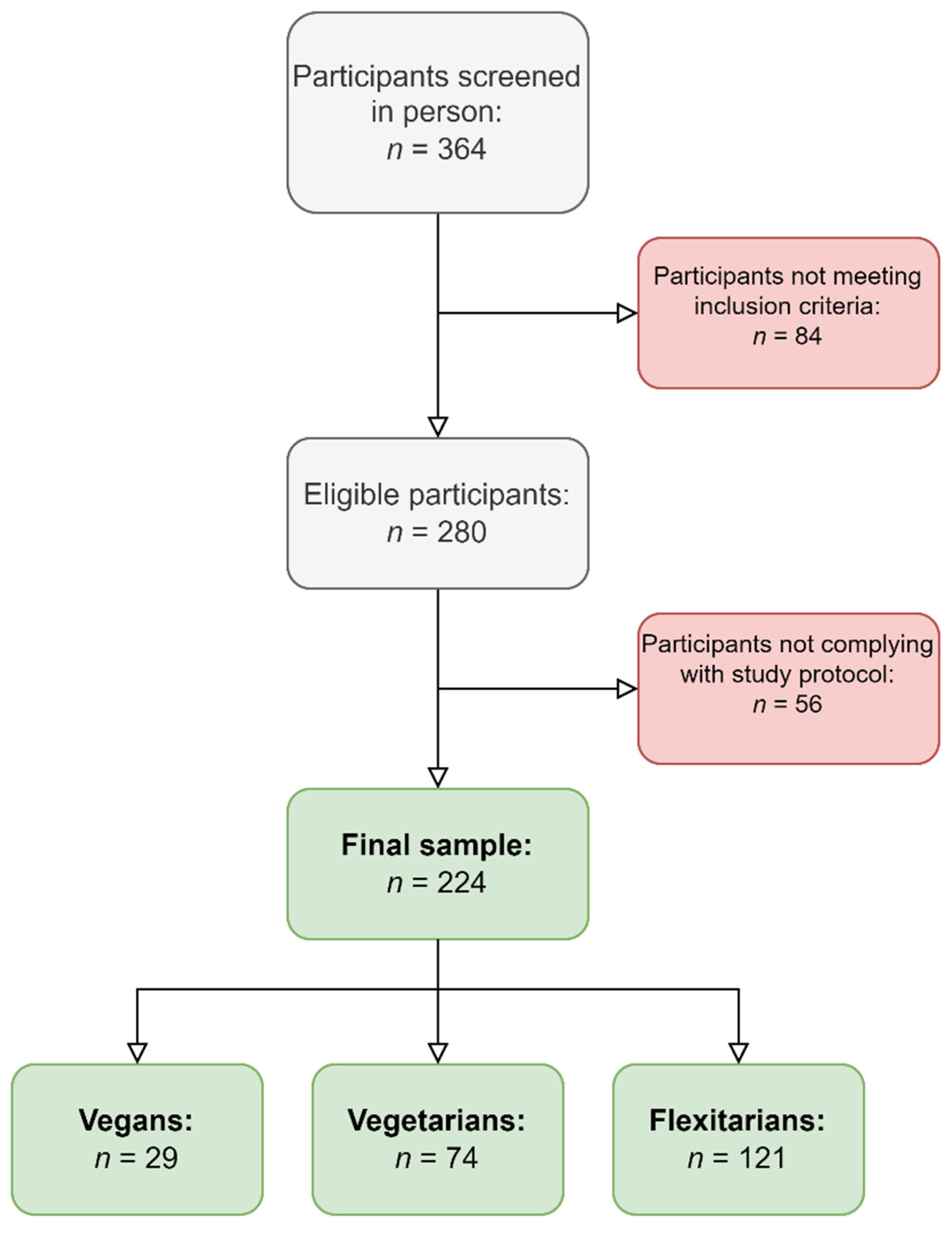Correction: Ekmeiro-Salvador, J.E.; Storz, M.A. The Impact of Plant-Based Diets on Dietary Acid Load Metrics in Venezuela: A Cross-Sectional Study. Nutrients 2023, 15, 2745
Error in Figure 1
Error in Table 4
Reference
- Ekmeiro-Salvador, J.E.; Storz, M.A. The Impact of Plant-Based Diets on Dietary Acid Load Metrics in Venezuela: A Cross-Sectional Study. Nutrients 2023, 15, 2745. [Google Scholar] [CrossRef] [PubMed]

| Independent Variables | β | SE | p | β | SE | p |
|---|---|---|---|---|---|---|
| PRALR | ||||||
| Model I | Model II | |||||
| Diet Category | ||||||
| Flexitarian | - | - | - | - | - | - |
| Lacto-Ovo-Vegetarian | −26.00 | 1.22 | <0.001 | −25.75 | 1.10 | <0.001 |
| Vegan | −44.42 | 1.71 | <0.001 | −42.82 | 1.60 | <0.001 |
| Sex | ||||||
| Female | −3.06 | 1.04 | 0.003 | |||
| Male | - | - | - | |||
| Body mass index | 0.89 | 0.14 | <0.001 | |||
| NEAPR | ||||||
| Model I | Model II | |||||
| Diet Category | ||||||
| Flexitarian | - | - | - | - | - | - |
| Lacto-Ovo-Vegetarian | −26.24 | 1.59 | <0.001 | −25.85 | 1.13 | <0.001 |
| Vegan | −47.25 | 2.22 | <0.001 | −42.79 | 1.65 | <0.001 |
| Sex | ||||||
| Female | −8.89 | 1.07 | <0.001 | |||
| Male | - | - | - | |||
| Body mass index | 1.58 | 0.15 | <0.001 | |||
| NEAPF | ||||||
| Model I | Model II | |||||
| Diet Category | ||||||
| Flexitarian | - | - | - | - | - | - |
| Lacto-Ovo-Vegetarian | −15.68 | 0.44 | <0.001 | −15.58 | 0.38 | <0.001 |
| Vegan | −26.04 | 0.62 | <0.001 | −24.99 | 0.56 | <0.001 |
| Sex | ||||||
| Female | −1.51 | 0.36 | <0.001 | |||
| Male | - | - | - | |||
| Body mass index | 0.36 | 0.05 | <0.001 | |||
Disclaimer/Publisher’s Note: The statements, opinions and data contained in all publications are solely those of the individual author(s) and contributor(s) and not of MDPI and/or the editor(s). MDPI and/or the editor(s) disclaim responsibility for any injury to people or property resulting from any ideas, methods, instructions or products referred to in the content. |
© 2025 by the authors. Licensee MDPI, Basel, Switzerland. This article is an open access article distributed under the terms and conditions of the Creative Commons Attribution (CC BY) license (https://creativecommons.org/licenses/by/4.0/).
Share and Cite
Ekmeiro-Salvador, J.E.; Storz, M.A. Correction: Ekmeiro-Salvador, J.E.; Storz, M.A. The Impact of Plant-Based Diets on Dietary Acid Load Metrics in Venezuela: A Cross-Sectional Study. Nutrients 2023, 15, 2745. Nutrients 2025, 17, 2077. https://doi.org/10.3390/nu17132077
Ekmeiro-Salvador JE, Storz MA. Correction: Ekmeiro-Salvador, J.E.; Storz, M.A. The Impact of Plant-Based Diets on Dietary Acid Load Metrics in Venezuela: A Cross-Sectional Study. Nutrients 2023, 15, 2745. Nutrients. 2025; 17(13):2077. https://doi.org/10.3390/nu17132077
Chicago/Turabian StyleEkmeiro-Salvador, Jesús Enrique, and Maximilian Andreas Storz. 2025. "Correction: Ekmeiro-Salvador, J.E.; Storz, M.A. The Impact of Plant-Based Diets on Dietary Acid Load Metrics in Venezuela: A Cross-Sectional Study. Nutrients 2023, 15, 2745" Nutrients 17, no. 13: 2077. https://doi.org/10.3390/nu17132077
APA StyleEkmeiro-Salvador, J. E., & Storz, M. A. (2025). Correction: Ekmeiro-Salvador, J.E.; Storz, M.A. The Impact of Plant-Based Diets on Dietary Acid Load Metrics in Venezuela: A Cross-Sectional Study. Nutrients 2023, 15, 2745. Nutrients, 17(13), 2077. https://doi.org/10.3390/nu17132077






